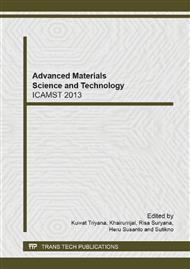p.241
p.245
p.249
p.253
p.259
p.263
p.267
p.272
p.276
Biomimetic Creation of Surfaces on Porous Titanium for Biomedical Applications
Abstract:
Titanium and titanium alloys have been extensively studied for many applications in the area of bone tissue engineering. However, dense titanium is prone to lead into aseptic loosening due to their high elastic modulus compared to natural bone. One way to lower the elastic modulus is to produce a porous structure of the metallic alloy by adjusting its porosity. Another concern is the bioinertness of titanium that have no direct chemical bonding with surrounding tissue. One approach to improve the healing process is the application of a calcium phosphate coating onto the surface of biomedical devices and implants. Biomimetic creation of surface using alkali heat treatment with silica addition was employed in this study. The porosity of the samples ranges from 60% to 70%. It was demonstrated that the biomimetic methods are suitable for inducing apatite on the titanium alloys surface.
Info:
Periodical:
Pages:
259-262
Citation:
Online since:
February 2014
Keywords:
Price:
Сopyright:
© 2014 Trans Tech Publications Ltd. All Rights Reserved
Share:
Citation:


